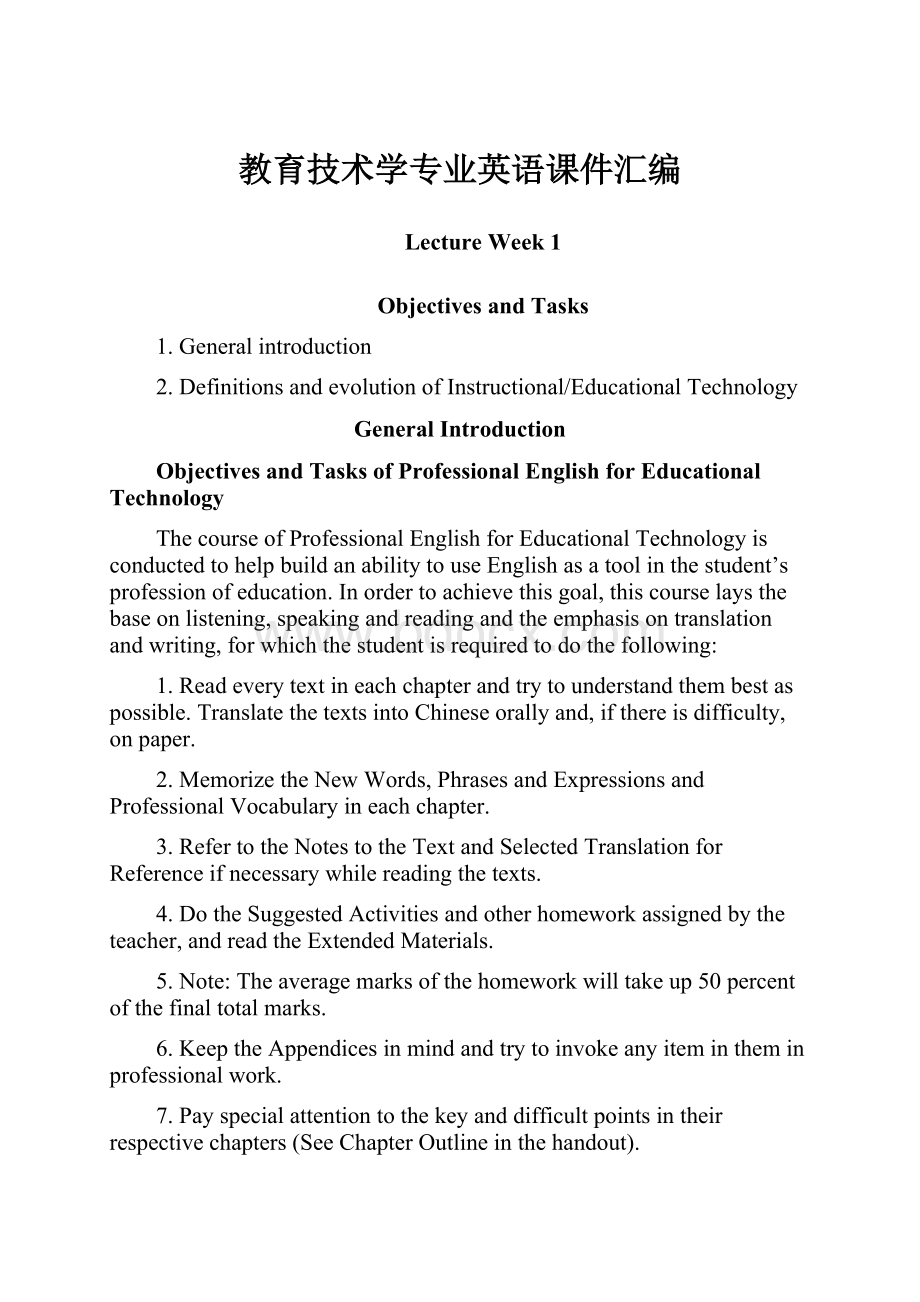教育技术学专业英语课件汇编.docx
《教育技术学专业英语课件汇编.docx》由会员分享,可在线阅读,更多相关《教育技术学专业英语课件汇编.docx(68页珍藏版)》请在冰豆网上搜索。

教育技术学专业英语课件汇编
LectureWeek1
ObjectivesandTasks
1.Generalintroduction
2.DefinitionsandevolutionofInstructional/EducationalTechnology
GeneralIntroduction
ObjectivesandTasksofProfessionalEnglishforEducationalTechnology
ThecourseofProfessionalEnglishforEducationalTechnologyisconductedtohelpbuildanabilitytouseEnglishasatoolinthestudent’sprofessionofeducation.Inordertoachievethisgoal,thiscourselaysthebaseonlistening,speakingandreadingandtheemphasisontranslationandwriting,forwhichthestudentisrequiredtodothefollowing:
1.Readeverytextineachchapterandtrytounderstandthembestaspossible.TranslatethetextsintoChineseorallyand,ifthereisdifficulty,onpaper.
2.MemorizetheNewWords,PhrasesandExpressionsandProfessionalVocabularyineachchapter.
3.RefertotheNotestotheTextandSelectedTranslationforReferenceifnecessarywhilereadingthetexts.
4.DotheSuggestedActivitiesandotherhomeworkassignedbytheteacher,andreadtheExtendedMaterials.
5.Note:
Theaveragemarksofthehomeworkwilltakeup50percentofthefinaltotalmarks.
6.KeeptheAppendicesinmindandtrytoinvokeanyitemintheminprofessionalwork.
7.Payspecialattentiontothekeyanddifficultpointsintheirrespectivechapters(SeeChapterOutlineinthehandout).
8.Previewbeforeanewlessonbegins.
9.Howtopreview
1)Readthroughallthetextstobestudiednexttimeandrefertoanymaterialsinoroutofthetextsifnecessary;
2)Markoutanyquestionsordifficulty;
3)Prepareanyquestionstoaskinclass;and
4)GetreadytosaysomethinginEnglishinclass.
StructureoftheBookandTimeAllocation
1.Structureofthebook
1)Unit1AnOverviewofInstructionalTechnology
2)Unit2TheTheoreticalFoundationofEducationalTechnology
3)Unit3MediaandLearning
4)Unit4InstructionalDesign
5)Unit5TheInformationTechnologyandEducation
6)Unit6DistanceEducation
7)Unit7ResearchMethodologiesforInstructionalTechnology
2.Timeallocation:
Roughlyfourhoursforeachunit
ChapterOneTheEvolutionoftheDefinitions
KeyPoint:
TheAECT’sDefinitionsin1994
DifficultPoint:
TheAECT’sDefinitionsin1994
1.Earlydefinitions(pp.3-5)
1)The1963definition(Ely)(p.3)
a)Audiovisualcommunication(formaldenomination/name)
b)Amajordeparturefromtheearliermedia-orienteddefinition
c)Focusonlearningratherthanteaching
2)The1970definitionintwoways(CommissiononInstructionalTechnology)(p.
a)Instructionaltechnology(formaldenomination)
b)Thefirstdefinition:
Instructionaltechnologyasmedia,conceptsexpressedfromtheaudiovisualpast
c)Theseconddefinition:
Instructionaltechnologyasaprocess,introducingnewconceptssuchassystematic,objectivesandevaluation
3)Another1970definition(Silber,AECT)(p.4):
Theideaof“problems’isfirstintroducedandatthecoreofthedefinition.
4)The1971definition(inEly)(p.5):
Thetermeducationaltechnologyisused.
5)The1972definition(AECT)(p.4):
asprocesses,notmuchdifference
6)The1977definition(AECT)(p.4):
asprocess,notmuchdifference
2.Evolutionofdefinitionanddifferencesfromonedefinitiontoanother(thewholechapter)
3.AECT’sdefinitionsin1994(pp.5-6)
1)Fiveseparateareasofconcern:
design,development,utilization,management,andevaluation
2)Adevelopmentfromtheprevious;notprocess-oriented
3)DomainsofInstructionalTechnology(p.5)
4)RelationshipbetweenDomainsoftheField(p.6)
5)SimilardefinitiongivenbyReiser,2001,butwiththenameofinstructionaldesignandtechnologyratherthaninstructionaltechnology
4.AssumptionsbehindAECT’sdefinitionin2005(pp.6-8)
1)Definition:
atemporaryone,asnapshotintime
Educationaltechnologyisthestudyandethicalpracticeoffacilitatinglearningimprovingperformancebycreating,using,andmanagingappropriatetechnologicalprocessesandresources.
2)Assumptionsbehindit
a)Ageneraldefinition,astipulatorydefinition
b)Adefinitionintendingtobeclear,precise,andunambiguous,andtodrawboundaries
c)Adefinitionreferringexplicitlytocorevaluesimpliedineducationaltechnology,amajordeparturefrompastAECTdefinitionalefforts
d)AdefinitionmeanttobeconnectedwithAECT’smostrecentpriordefinitionof1994,asanimprovementandupdating,evolutionaryratherthanrevolutionary
e)Adefinitionsensitivetothestandardsfortheaccreditationofuniversityprogramspreparingteachersandspecialistsintheeducationaltechnologyfield
f)Adefinitionasinclusiveaspossible
5.MissioncurrentlyembracedbyAECT(p.8)
Toprovideinternationalleadershipbypromotingscholarshipandbestpracticesinthecreation,use,andmanagementoftechnologiesforeffectiveteachingandlearninginawiderangeofsettings.
6.Futureofdefinition(p.8):
subjecttoparadigmshift
Reference
Ely,DonaldP.–Ph.D.,SyracuseUniversity,CommunicationsandPsychology,1961,ProfessorandChair,InstructionalDesign,DevelopmentandEvaluation;AssociateDirector,ERICClearinghouseonInformationandTechnologySyracuseUniversity,NewYork
Seels,BarbaraB.–SchoolofEducation,UniversityofPittsburgh,5142WesleyW.PosvarHall,Pittsburgh,PA15260(Ph.D.,MassCommunications,OhioStateUniversity,1970;M.S.,InstructionalCommunications,SyracuseUniversity,1963;B.A.,English&Drama,BucknellUniversity,1961)
Richey,RitaC.–Dr.RitaC.RicheyisProfessorandProgramCoordinatorinInstructionalTechnologyfortheCollegeofEducationatWayneStateUniversity,Detroit,Michigan.ShereceivedherB.A.inEnglishfromtheUniversityofMichigan,herM.A.inPsychologyofReadingfromtheUniversityofMichiganandherPh.D.inInstructionalTechnologyfromWayneStateUniversity.Dr.Richey'steachingandresearchinterestsincludeInstructionalDesign,ResearchandTheoryinInstructionalTechnology,HistoryandTrendinInstructionalTechnology.
Silber,Kenneth–Dr.KennethSilberisthefounderandPresidentofSilberPerformanceConsulting,Chicago,Illinois.HeholdsaPh.D.andM.A.inInstructionalTechnology,withminorsinOrganizationalandEducationalPsychologyfromtheUniversityofSouthernCalifornia,andaB.A.withamajorinPsychologyfromtheUniversityofRochester.HespeaksFrenchandhasstudiedattheAllianceFrancaisesince1981.
Homework
1.SuggestedActivitiesandExtendedMaterials.
2.TrytounderstandSelectedTranslationforReference
3.PreviewChapters2
LectureWeek2
ObjectivesandTasks
LearntheHistoryofinstructionaltechnology
ChapterTwoTheHistoryofInstructionalTechnology
KeyPoint:
1980s-Present
DifficultPoint:
1950s-1970s
SectionABefore1920
1.Theory
1)E.L.Thorndike(1874-1949),abehavioralpsychologistatColumbiaUniversity,anearlyfigureintheefforttoestablishascientificknowledgebasefortheresearchofhumanlearning,especiallyforinstructionaltechnology(p.13)HewasthefounderofLaboratoryAnimalPsychology.Hiscontributiontoinstructionaltechnology
a)ThelawofEffect
b)establishascientificknowledgebase
Behaviorism:
Basedonobservablechangesinbehavior.Behaviorismfocusesonanewbehavioralpatternbeingrepeateduntilitbecomesautomatic.
2)JohnDeway(1859-1952)andProgressivism(p.13)
Learningbydoing
Experience+Reflection=Learning
前者是指学习者从实际操作中获得学习,例如幼童从操弄实物个数而获得“数字”概念。
后者是指学习者除了实地亲身体验外,还必须反省思考经验的意义,使学习进一步加深。
2.Practice
Audioinstructionsandaudiovisualinstructions(p.13)
SectionBBetweenthe1920sand1940s
1.Theaudiovisualmovement(pp.13-14)
UsingVisualsandtremendousgrowthinthevisualinstructionalmovement.
Theformationofprofessionalorganizations:
1)TheNationalAcademyforVisualInstruction(1919)
2)TheAmericanEducationalMotionPicture(1919)
3)TheDepartmentofVisualInstruction(DVI)(1923)
4)TheVisualInstructionAssociationofAmerica(1922)
2.Majoreventsthatinfluencedthefuturedevelopmentofthemovement(p.14)
1)Thebehavioralobjectivemovement行为目标运动
a)Earlyadvocates:
Bobbitt,Charters,andBurk
b)RalphTyler(1902-1994),fatherofthebehavioralobjectivemovement
c)HisEight-YearStudyintheOhioStateUniversity(1933-1941)anditssignificance
2)ThemediapersonnelandpsychologistinthemilitaryagentduringWorldWarII(p.14)
3)Workswrittenduringthisperiod(p.14)
4)EdgarDale(1900-1985)andhisConeofExperience(pp.14-15)
YearsagoaneducatornamedEdgarDale,oftencitedasthefatherofmodernmediaineducation,developedfromhisexperienceinteachingandhisobservationsoflearnersthe"coneofexperience"(seeFigure1).Thecone'sutilityinselectinginstructionalresourcesandactivitiesisaspracticaltodayaswhenDalecreatedit.
SectionCBetweenthe1950sand1970s
1.TheshiftfromAudiovisualInstructiontoInstructionalTechnology(pp.15-17)
Trendsaffectingtheevolutionofthefield:
1)Programmedinstructionandtaskanalysis(p.15)
a)Definitionofprogrammedinstruction(p.15Secondlinefromthebottom)
b)SydneyL.Presseyandhisfirstteachingmachine(1934)(p.15Para.2)
c)B.F.Skinner(1904-1990)ofHarvardUniversityandhis“SkinnerBox”(p.15para.2)
d)RobertGlaserandhistermInstructionalSystem(1962)(p.16)
e)RobertM.Gagnéandtaskanalysis(1965)(p.16)threetechniquesfortaskanalysis:
topicanalysis;Proceduralanalysis;outline,flowchartortable
f)TheConditionsofLearningbyGagné(1965)andPrinciplesofInstructionalDesignbyGagnéandL.J.Briggs(1974)(p.16)
g)TheDickandCareyModel(1978)(p.16)
Duringthisperiod,instructionaltechnologybecamemoreandmorecomplexbecausethrewweremoreandmoret